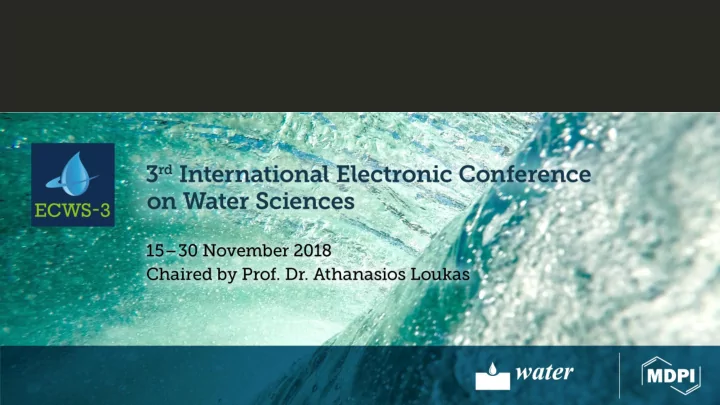

Temporal and elevation trend detection of rainfall erosivity density in Greece K. Vantas, E. Sidiropoulos and A. Loukas Department of Rural and Surveying Engineering, Aristotle University of Thessaloniki
Introduction
Introduction • Global warming is expected to increase the intensity of rainfall in Europe and consequently to increase the soil erosion rates . • This potential may have a significant impact especially on Greece, which is inflicted by the phenomenon of desertification. • Annual precipitation in Greece presents a downward trend for the period 1955-2001. • Available data, which are necessary for the calculation of rainfall erosivity in Greece, suffer from great amount of missing values.
Aims of the study • Assess the impact of missing values ratio to the computation of rainfall erosivity (R) and erosivity density (ED) values in a numerical way. • Investigate ED temporal trends in Greece taking into account the presence of missing values in precipitation records. • Test the hypothesis that mean ED is independent of elevation.
Dataset
108 Meteorological stations utilized in the analysis
18 Meteorological stations selected Criteria: 1. The stations must have a common time length of at least 30 years 2. During these years the coverage must be at least 45%.
Methods
Rainfall erosivity density
Rainfall erosivity 𝑛 𝐹𝐽 30 = 𝑓 𝑠 ⋅ 𝑤 𝑠 ⋅ 𝐽 30 𝑠=1 • 𝐹𝐽 30 is the product of the kinetic energy of a rainfall and its maximum 30 min intensity (MJ.mm/ha/h), • 𝑓 𝑠 is the kinetic energy per unit of rainfall (MJ/ha/mm), • 𝑤 𝑠 the rainfall depth (mm) for the time interval r of the hyetograph, which has been divided into r=1,2,…,m sub -intervals, • 𝐽 30 is the maximum rainfall intensity for a 30 minutes duration.
Kinetic energy equation 𝑓 𝑠 = 0.29 ⋅ 1 − 0.72 𝑓 − 0.82 𝑗 𝑠 • 𝑓 𝑠 is the kinetic energy per unit of rainfall (MJ/ha/mm) and • 𝑗 𝑠 is the rainfall intensity (mm/hr). This equation has been used in RUSLE2.
Rules applied • A rainfall event was divided into two parts, if its cumulative depth for duration of 6 hours at a certain location is less than 1.27 mm. • A rainfall is considered erosive if it has a cumulative value greater than 12.7 mm and these were used in the calculations. • On the grounds that the use of fixed time intervals to measure maximum rainfall amounts can lead to an underestimation of the true value, the Hershfield factor equal to 1.14 was used. • All rainfalls with extreme EI30 values and a return period greater than 50 years were deleted using the IDF curves for each station.
Rainfall erosivity density 𝑛 𝑘 σ 𝑙=1 𝐹𝐽 30 𝑙 𝐹𝐸 𝑘 = 𝑄 𝑘 𝑘 is the annual rainfall erosivity density for the year j (MJ/ha/h), • 𝐹𝐸 • 𝑛 𝑘 is the number of storms during year j , • 𝐹𝐽 30 𝑙 is the erosivity of storm k and 𝑘 is the annual precipitation height. • 𝑄
Monte Carlo Procedure
Monte Carlo procedure 1. A subset of the calculated EI30 values is extracted based on the data coverage and the water divisions for the selected stations. 2. For 1,000 iterations a random sample per station and year is extracted to simulate different missing values ratios 3. The mean absolute percentage error (MAPE) is computed using the initial and the sampled values of ED and R.
Monte Carlo procedure 𝑜 𝑁𝐵𝑄𝐹 = 1 𝑍 𝑢 − 𝑍 𝑢,𝑛𝑗𝑡𝑡 𝑜 𝑍 𝑢 𝑢=1 • 𝑢 = [1, … , 𝑜] is the year, 𝑢 is the computed annual value using all rainfall events per station • 𝑍 and 𝑢,𝑛𝑗𝑡𝑡 is the computed value coming from the random sample. • 𝑍
Statistical analysis
Statistical analysis and tests • The autocorrelation coefficient function (ACF) and the partial correlation coefficient function (PACF) were compiled in order to investigate the presence of serial correlation in the annual ED values per station. • For every selected station the hypothesis that ED does not change over time is tested using the Kendall’s Tau rank correlation value and the resulting p-values per station were adjusted using the Benjamini & Hochberg method in order to control the false discovery rate (FDR) due to multiple statistical testing.
Statistical analysis and tests • The Kendall’s Tau rank correlation value and the resulting p -value was utilized to test the hypothesis that the ED values per station are not affected by the elevation.
Results
Monte Carlo Procedure • ED is more robust against the presence of missing precipitation values. • R is inversely proportional underestimated as the coverage ratio increases, while ED’s estimation error follows a parabolic curve.
Temporal trends • The samples’ autocorrelation coefficient functions and the partial correlation coefficient functions did not reveal any practical meaning of the statistically significant values that were found at specific lags. • The Kendall’s Tau rank correlation test results indicate that for all the stations, except one, the null hypothesis that annual ED values change over time could not be rejected for a significance level α = 5%. It is reasonable to suppose that these time series are realizations of stationary processes.
Elevation trend The null hypothesis that annual ED values is affected by the elevation could not be rejected for the significance level α = 5% (p-value = 0.053).
Conclusions
Conclusions 1. It is suggested to compute ED for the assessment of erosivity in Greece instead of the direct computation of R due to the large proportion of missing values in the pluviograph records. 2. Stationarity of ED was found for the majority of the selected stations, in contrast to reported precipitation trends for the same time period. 3. The hypothesis that ED values are not correlated to elevation could not be rejected.
The analysis and the algorithms were implemented in the R language using the packages: hydroscoper, hyetor, ggplot2, tidyverse.
Thank you for your attention
Recommend
More recommend